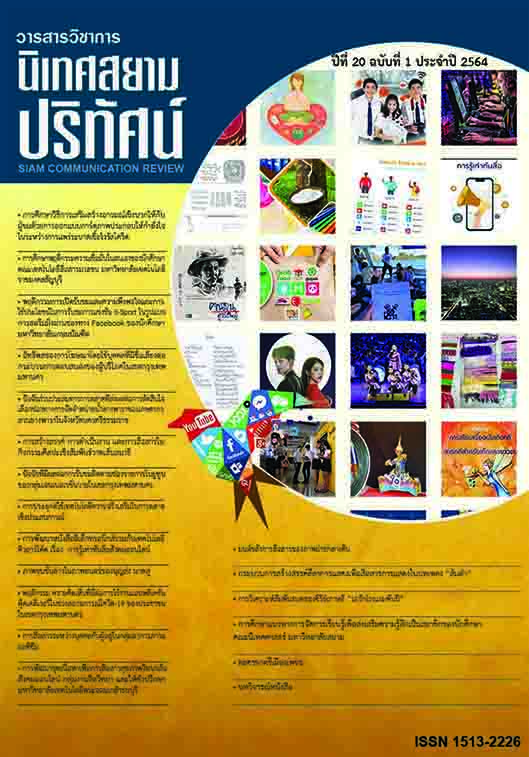The Influence of Advertising Using Celebrities as Presenters on Consumers Response Process in Bangkok
Main Article Content
Abstract
The objectives of this current survey research are 1) to study the opinions of consumers towards advertising using celebrities, 2) to study the process of consumer response after watching the advertisements using celebrities, and 3) to study the relationship between advertising using celebrities and the consumer response process. The sample size of this survey research is 447 consumers. The data collection tool is a questionnaire. The data was analyzed using percentage, average, and correlation coefficient.
The following are the research results. The opinions of research participants towards advertising using celebrities related to the following aspects are shown below. First, attractiveness: the sample was primarily interested in celebrities with good manners. Second, trustworthiness: the sample primarily trusted presenters with good images and demeanor. Third, expertise: the sample primarily believed in celebrities who used their skills and their expertise to guarantee the accuracy of the products. Fourth, respect: the sample primarily agreed that advertising using presenters who are admirable and are role models of the society is appropriate. Finally, similarity: the sample thought that advertisements that allow them to follow Thai presenters who have similar lifestyle as theirs makes them become more interested in the products than advertising using non-Thai celebrities.
Regarding the sample’s opinions towards consumer response process, it was at a very high level. The sample’s opinions towards each aspect of consumer response are as follows.1) Attention (A): The sample agreed that packaging design draws the attention of the customers to buy the product. 2) Interest (I): the sample thought that products that clearly describe their quality and benefits can persuade customers to purchase the products. 3) Desire (D): the sample claimed that the reputation of the product’s brand can attract customers to buy the products. 4) Action (A) the sample suggested that they decide to buy the products by considering the qualities or benefits of the products.
Article Details
References
ณัฎฐ์หทัย เจิมแป้น. (2558). การโฆษณาโดยบุคคลที่มีชื่อเสียงมีอิทธิพลต่อการตัดสินใจซื้อผลิตภัณฑ์สก็อตของผู้บริโภคในเขตกรุงเทพมหานคร วิทยานิพนธ์ปริญญามหาบัณฑิต คณะบริหารธุรกิจ, มหาวิทยาลัยกรุงเทพ.
ดนัย เรียบสกุล. (2551). แนวทางการออกแบบการ์ดเชิญในประเทศไทย. วิทยานิพนธ์ปริญญามหาบัณฑิต สาขาการออกแบบนิเทศศิลป์, มหาวิทยาลัยศิลปากร.
นันท์ โฆษิตสกุล. (2551). การใช้บุคคลที่มีชื่อเสียง (Celebrity) เป็นผู้นำเสนอสินค้า (Presenter) และทูตตราสินค้า (Brand Ambassador) ในงานโฆษณา. สารนิพนธ์ปริญญาบัณฑิต คณะวารสารศาสตร์และสื่อมวลชน, มหาวิทยาลัยธรรมศาสตร์.
ภัสราพร รัตนชาติ. (2557). ภาพลักษณ์ความน่าเชื่อถือของบุคคลที่มีชื่อเสียงและกลยุทธ์การค้าปลีกที่มีผลต่อการตัดสินใจซื้อเครื่องสำอางบนห้างสรรพสินค้าของผู้หญิงวัยทำงานในเขตกรุงเทพมหานคร. วารสารสุทธิปริทัศน์, 28(88), 385-407.
ภัสสรนันท์ อเนกธรรมกุล. (2553). ผลกระทบจากการใช้บุคคลที่มีชื่อเสียง (Celebrity) ที่เป็นผู้นำเสนอสินค้าหลากหลายตราสินค้าในงานโฆษณา. วิทยานิพนธ์ปริญญามหาบัณฑิต สาขาการบริหารการตลาดบัณฑิตวิทยาลัย, มหาวิทยาลัยธรรมศาสตร์.
ภาณุพงศ์ ม่วงอินทร์. (2558). ประสิทธิภาพการสื่อสารทางตลาดผ่านสื่อออนไลน์โดยใช้บุคคลที่มีชื่อเสียง ส่งผลต่อการตั้งใจซื้อเครื่องสําอางค์ของผู้บริโภค. วิทยานิพนธ์ปริญญามหาบัณฑิต, มหาวิทยาลัยกรุงเทพ.
ภานุพงศ์ เตจ๊ะ. (2558). ทัศนคติของผู้บริโภคที่มีต่อการโฆษณาผ่านบุคคลที่มีชื่อเสียงทางโซเชียลมีเดีย. การศึกษาเฉพาะบุคคลปริญญามหาบัณฑิต, มหาวิทยาลัยธรรมศาสตร์.
รณพร สุวรรณานนท์. (2551). การโฆษณาทางวิทยุโทรทัศน์ มีผลต่อการตัดสินใจซื้อรองเท้าสตรีในห้างสรรพสินค้าของประชาชนเขตกรุงเทพมหานคร. วิทยานิพนธ์ปริญญามหาบัณฑิต สาขาสื่อสารมวลชน ,มหาวิทยาลัยรามคำแหง.
ภาษาอังกฤษ
Bovee, C.L., Houston, M.J., & Thill, J.V. (1995). Marketing (2nd ed.). London: McGraw-Hill.
Charbonneau, J , & Garland, R.(2005) The use of celebrity athletes as endorsers: views of the New Zealand general public. International Journal of Sports Marketing and Sponsorship, 7(4), 326-333.
Etzel, M. J., Walker, B. J., & Stanton, W. J. (2001). Marketing (12th ed.). Boston: McGraw-Hill.
Freeman, R.E. (1984). Strategic management: a stakeholder approach. Boston: Pitman.
Taro Yamane. (1973). Statistics: An Introductory Analysis (3rd ed.) New York: Harper and Row.
ระบบออนไลน์
ข้อมูลสถิติประชากรปี พ.ศ.2562. (2562). Retrieved from http://stat.dopa.go.th
Herbert C. Kelman. (2002). Attitude Change. Retrieved from http://www.novabizz.com//NovaAce/Self/Spiritual/Attitude_11.php – 20k.

